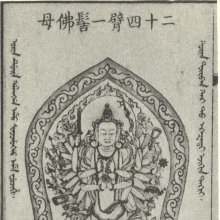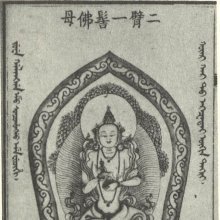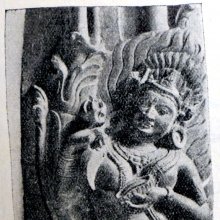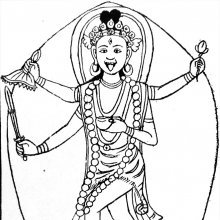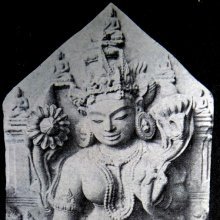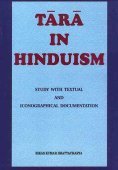Ekajata, Ēkajāta, Ekajāta, Ekajaṭā, Eka-jata, Ekajaṭa: 13 definitions
Introduction:
Ekajata means something in Buddhism, Pali, Hinduism, Sanskrit, Marathi. If you want to know the exact meaning, history, etymology or English translation of this term then check out the descriptions on this page. Add your comment or reference to a book if you want to contribute to this summary article.
Images (photo gallery)
(+6 more images available)
In Hinduism
Purana and Itihasa (epic history)
Source: archive.org: Puranic Encyclopedia1) Ekajaṭā (एकजटा).—A demoness of the castle of Rāvaṇa. This demoness talked very enticingly to coax Sītā to surrender herself to Rāvaṇa. (Sarga 23, Vālmīki Rāmāyaṇa, Sundara Kāṇḍa).
2) Ekajaṭa (एकजट).—A warrior of Skandadeva. (Śloka 53, Chapter 45, Śalya Parva).

The Purana (पुराण, purāṇas) refers to Sanskrit literature preserving ancient India’s vast cultural history, including historical legends, religious ceremonies, various arts and sciences. The eighteen mahapuranas total over 400,000 shlokas (metrical couplets) and date to at least several centuries BCE.
In Buddhism
Tibetan Buddhism (Vajrayana or tantric Buddhism)
Source: archive.org: The Indian Buddhist IconographyEkajaṭā (एकजटा) refers to one of the female emanations of Akṣobhya, as mentioned in the 5th-century Sādhanamālā (a collection of sādhana texts that contain detailed instructions for rituals).—Her Colour is blue; her Appearance is terrible; her Attitude is the pratyālīḍha.—Ekajaṭā is one of the most powerful goddesses in the Vajrayāna pantheon. It is said in the Sādhanamālā that if a person listens to her mantra but once, he is at once freed from all obstacles and is attended always with good fortune, his enemies are destroyed and he becomes religiously inclined, even attaining the level of a Buddha.
Ekajaṭā may have several forms with blue colour, and she bears the image of her sire Akṣobhya on her crown in all cases. All her forms have been described previously along with the other emanations of the Dhyāni Buddha Akṣobhya including the terrible form which goes by the name of Vidyujjvālākarālī of blue colour, with twelve faces and twenty-four arms.
The Dhyāna (meditation instructions) of Ekajaṭā described in the Sādhanamālā as follows:—
“All these (three) forms (of Ekajaṭā) are of blue colour, have the tiger-skin round their loins, are one-faced and three-eyed, and have brown hair rising upwards on their head. They are short, pot-bellied, wrathful and stand in the pratyālīḍha attitude, they have faces distorted with anger; with garlands of heads hanging from their necks, they rest on corpses, are terrible in appearance and bear the image of Akṣobhya on the crown. They have youthful bloom and laugh horribly and they should be conceived on the orb of the sun over the double lotus”.
[This general description only applies to the following three forms of Ekajaṭā with one face and two, four or eight arms:
(i) When two-armed, Ekajaṭā carries the kartri and the Karoṭa (skull-cup) in her two hands (Fig. 138).
(ii) When four-armed, Ekajaṭā carries the arrow and the sword in the two right hands and the bow and the skull in the two left. In two other sādhanas describing the four-armed variety, her appearance undergoes a slight modification. Here she holds in the first pair of hands the kapāla and the kartri, while the other pair shows the utpala and the sword. She may hold also the rosary instead of the sword (Fig. 139).
(iii) When eight-armed, Ekajaṭā carries the sword, the arrow, the vajra and the kartri in the four right hands and the bow, the utpala, the paraśu and the skull in the four left hands.]

Tibetan Buddhism includes schools such as Nyingma, Kadampa, Kagyu and Gelug. Their primary canon of literature is divided in two broad categories: The Kangyur, which consists of Buddha’s words, and the Tengyur, which includes commentaries from various sources. Esotericism and tantra techniques (vajrayāna) are collected indepently.
Languages of India and abroad
Marathi-English dictionary
Source: DDSA: The Molesworth Marathi and English Dictionaryēkajāta (एकजात).—ad Purely or merely; simply and singly; that altogether and only; without mixture of other (substance or quality).
Source: DDSA: The Aryabhusan school dictionary, Marathi-Englishēkajāta (एकजात).—ad Purely, simply, singly, with- out mixture of other. a Pure, of one single kind, without admixture.
Marathi is an Indo-European language having over 70 million native speakers people in (predominantly) Maharashtra India. Marathi, like many other Indo-Aryan languages, evolved from early forms of Prakrit, which itself is a subset of Sanskrit, one of the most ancient languages of the world.
Sanskrit dictionary
Source: DDSA: The practical Sanskrit-English dictionaryEkajaṭā (एकजटा).—Name of a goddess उग्रतारा (ugratārā).
Ekajaṭā is a Sanskrit compound consisting of the terms eka and jaṭā (जटा).
--- OR ---
Ekajāta (एकजात).—a. born of the same parents; Manusmṛti 9.148.
Ekajāta is a Sanskrit compound consisting of the terms eka and jāta (जात).
Source: Cologne Digital Sanskrit Dictionaries: Edgerton Buddhist Hybrid Sanskrit DictionaryEkajaṭā (एकजटा).—(1) name of a goddess, form of Tārā (= Eka- jaṭī): Sādhanamālā 254.1 etc.; (2) name of a mahāpiśācī (the same?): Mahā-Māyūrī 242.29.
--- OR ---
Ekajaṭā (एकजटा) or Ekajaṭī.—(1): Mahāvyutpatti 4277 (compare Tārā 4280).
Source: Cologne Digital Sanskrit Dictionaries: Shabda-Sagara Sanskrit-English DictionaryEkajāta (एकजात).—mfn.
(-taḥ-tā-taṃ) Of one parentage, born of the same parents. E. eka and jāta born.
Source: Cologne Digital Sanskrit Dictionaries: Cappeller Sanskrit-English DictionaryEkajāta (एकजात).—[adjective] born of the same parents.
Source: Cologne Digital Sanskrit Dictionaries: Monier-Williams Sanskrit-English Dictionary1) Ekajaṭa (एकजट):—[=eka-jaṭa] [from eka] m. Name of a being in the retinue of Skanda, [Mahābhārata]
2) Ekajaṭā (एकजटा):—[=eka-jaṭā] [from eka-jaṭa > eka] f. Name of a goddess, [Tantrasāra] ([Tārānātha tarkavācaspati’s Vācaspatyam, Sanskrit dictionary])
3) Ekajāta (एकजात):—[=eka-jāta] [from eka] mfn. of one parentage, born of the same parents, [Manu-smṛti ix, 148; 182.]
Source: Cologne Digital Sanskrit Dictionaries: Yates Sanskrit-English DictionaryEkajāta (एकजात):—[eka-jāta] (taḥ-tā-taṃ) a. Of one caste.
[Sanskrit to German]
Sanskrit, also spelled संस्कृतम् (saṃskṛtam), is an ancient language of India commonly seen as the grandmother of the Indo-European language family (even English!). Closely allied with Prakrit and Pali, Sanskrit is more exhaustive in both grammar and terms and has the most extensive collection of literature in the world, greatly surpassing its sister-languages Greek and Latin.
Nepali dictionary
Source: unoes: Nepali-English DictionaryEkajāta (एकजात):—adv. 1. not a bit; 2. not at all; adj. of one parentage;
Nepali is the primary language of the Nepalese people counting almost 20 million native speakers. The country of Nepal is situated in the Himalaya mountain range to the north of India.
See also (Relevant definitions)
Starts with: Ekajatakalpa.
Full-text: Ekajati, Khadiravanitara, Khadiravani, Uttaramnaya, Amritalocana, Varada, Amritamukhi, Varadatara, Mahasri, Vidyujjvalakarali, Vashyatara, Cintamanimantra, Tara, Sitatara, Prasannatara, Ashtabhujakurukulla.
Relevant text
Search found 6 books and stories containing Ekajata, Eka-jata, Eka-jaṭā, Eka-jāta, Eka-jaṭa, Ēkajāta, Ekajāta, Ekajaṭā, Ekajaṭa; (plurals include: Ekajatas, jatas, jaṭās, jātas, jaṭas, Ēkajātas, Ekajātas, Ekajaṭās, Ekajaṭas). You can also click to the full overview containing English textual excerpts. Below are direct links for the most relevant articles:
The Indian Buddhist Iconography (by Benoytosh Bhattachacharyya)
Figure 166-168 - Emanations of Amoghasiddhi: Khadiravaṇī Tārā
Figure 138-139 - Emanations of Akṣobhya: Ekajaṭā
Sripura (Archaeological Survey) (by Bikash Chandra Pradhan)
Scultures of Buddhist Goddesses (1): Tara < [Chapter 3 - Sculptural Programme]
Stupas in Orissa (Study) (by Meenakshi Chauley)
Emanations of Amoghasiddhi < [Chapter 5]
The gods of northern Buddhism (by Alice Getty)
The Agni Purana (by N. Gangadharan)
Mahabharata (English) (by Kisari Mohan Ganguli)
Section 45 < [Shalya Parva]
Related products
